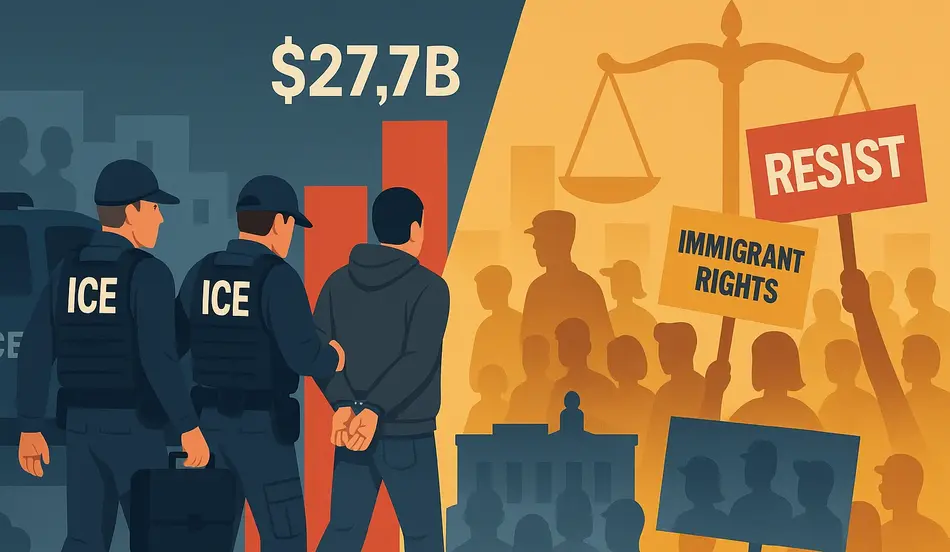ICE Raids in 2025 are intensifying as the agency ramps up operations with record funding. Communities across the nation are mobilizing to resist, while the expansion raises constitutional questions, human rights concerns, and fears of a defining shift in U.S. immigration policy.
A Nation at a Crossroads
The United States may be entering a defining moment in its immigration policy. This week, the Department of Homeland Security (DHS) announced a massive recruiting campaign for U.S. Immigration and Customs Enforcement (ICE), offering $50,000 signing bonuses, student loan forgiveness, and enhanced retirement benefits to entice 10,000 new agents. The budget for ICE enforcement will swell from $8 billion to $27.7 billion, an unprecedented expansion in scope and manpower.
The official mission, DHS Secretary Kristi Noem said in a press release, is to “target the worst of the worst.” But critics say reality tells a different story. Recent raids have swept up not just hardened criminals but restaurant cooks, grocery clerks, teenagers, and even lawful residents.
What happens next — both for the millions of undocumented immigrants and the communities mobilizing in their defense — could redefine the balance between law enforcement, civil liberties, and the fabric of American society.
Raids Across the Country
The escalation is not theoretical. In Kansas City, 11 restaurant workers were detained in the middle of their shifts at two Mexican restaurants. The arrests happened so abruptly that burners were left on in the kitchen.
In New York State, ICE agents descended on a popular Asian food market outside Buffalo, arresting multiple employees and forcing the store to shut down for the day. The store’s attorney called the action discriminatory, arguing the market was “targeted simply because it’s immigrant-owned.”
Meanwhile, in New Haven, Connecticut, protests erupted when an 18-year-old high school junior was detained in a workplace raid and transferred to a detention facility 1,500 miles away in Louisiana. More than 150 classmates, teachers, and residents rallied to demand his release.
These cases highlight the disconnect between the government’s rhetoric and on-the-ground enforcement. While officials frame the mission as removing violent offenders, critics argue everyday workers are bearing the brunt.

Resistance Spreads
Against this backdrop, resistance is spreading nationwide. Volunteer groups are forming to monitor ICE activity, warn communities, and provide legal and logistical support to those at risk.
One such volunteer explained to NBC News:
“If someone is being detained, we take their information, we let them know their rights, and we try to provide a safety net around their family.”
In Pasadena, California, a mother of five named Elizabeth Castillo has become a grassroots leader after witnessing raids in her neighborhood. At first, she used a megaphone and her car horn to warn neighbors when ICE vehicles appeared. Over time, she and local activists built a “Community Defense Corner” — a tent staffed by volunteers distributing “Know Your Rights” pamphlets, photographs of ICE vehicles, and even friendship bracelets with legal hotline numbers sewn inside.
These defense corners have since spread to other neighborhoods in Los Angeles, and similar grassroots networks are emerging in New York, Chicago, and Houston. Volunteers also stake out Home Depots and day-labor sites, warning workers when agents approach.
The message is simple: if ICE increases its presence, communities will respond.
Constitutional Questions
The expansion of raids has reignited debates about civil liberties and the First Amendment.
Legal experts argue protesters and volunteers have the constitutional right to monitor ICE activity, document arrests, and warn neighbors. James Sample, a Hofstra University law professor, explained:
“The protection they have is the First Amendment. That is as core to the First Amendment as you can get — political speech expressing disagreement with the government.”
However, the line is not absolute. Volunteers may not physically interfere with law enforcement operations, creating a legal gray area. Recent clashes in New York City, where community members protested arrests outside immigration courts, illustrate how easily these boundaries are tested.
For many activists, the challenge is walking that fine line: helping vulnerable neighbors while avoiding charges of obstruction.
The Human Cost
Beyond the legal debate lies a sobering reality: families are being torn apart.
Reports from Axios and local news outlets describe cases where workers are detained so quickly that families don’t know where they’ve been taken. Property is abandoned mid-shift. Pets are left behind, with shelters reporting a surge in surrendered dogs and cats after raids.
One homeowner told reporters his gardeners were arrested while mowing his lawn — leaving equipment running and their personal belongings behind.
Immigration advocates describe this as a form of “disappearance.” Without rapid legal support, detainees can vanish into the vast ICE detention system, transferred across state lines within hours.
An Expanding Apparatus
Critics worry that the $27.7 billion budget and 10,000 new agents will only accelerate these disappearances.
If approved, ICE’s budget would exceed the combined funding of the FBI, DEA, ATF, and U.S. Marshals Service. This scale of investment, experts warn, could normalize mass deportations and erode judicial oversight in the process.
The Biden and Trump administrations both faced criticism for immigration enforcement tactics, but the current expansion signals something different: a bipartisan willingness to build the largest deportation apparatus in U.S. history.
For immigrants and their allies, that means resistance — not just online, but on street corners, in courthouses, and in neighborhoods across the country.
Hire With Purpose in a Changing America
Post your job on WhatJobs and connect with candidates who value stability, community, and meaningful careers—no matter how policies and budgets shift.
Post a Job Now →Looking Ahead
Is this truly an “inflection point,” as DHS Secretary Kristi Noem called it? Many believe it is.
On one side, ICE is being armed with unprecedented funding, manpower, and political backing. On the other, grassroots groups are building resilient networks that empower ordinary citizens to protect their neighbors.
The collision course between these two forces — federal enforcement and community resistance — could shape immigration policy for a generation.
Frequently Asked Questions (FAQ)
1. What exactly happens during an ICE raid?
ICE raids vary, but typically agents arrive at workplaces, homes, or public spaces in unmarked vehicles. Witnesses report that agents often wear civilian clothes, cover their faces, and refuse to show ID. Detainees may be transferred quickly across state lines to detention centers.
2. Can legal residents or citizens be detained by mistake?
Yes. While ICE’s mission is to target undocumented immigrants, multiple reports confirm legal residents and even U.S. citizens have been mistakenly detained. In many cases, detainees were later released after proving their status — but only after enduring significant disruption.
3. What rights do undocumented immigrants have if detained?
Every person in the U.S., regardless of immigration status, has certain constitutional rights:
The right to remain silent (you don’t have to answer questions about birthplace or immigration status).
The right to an attorney (though not a free public defender in immigration court).
The right to refuse consent to entry unless ICE has a judicial warrant.
4. Why is ICE offering $50,000 signing bonuses?
The government hopes to recruit 10,000 new agents amid growing attrition and a massive expansion of enforcement goals. The bonuses, student loan forgiveness, and retirement perks are designed to compete with other federal law enforcement agencies and attract younger recruits.
5. How are communities resisting raids?
Resistance takes many forms:
Community defense corners distributing “Know Your Rights” materials.
Volunteers monitoring and filming ICE operations.
Hotlines and text networks warning of raids.
Legal aid groups tracking detainees through the immigration system.
Final Word
The United States is standing at a crossroads. ICE is preparing for its largest expansion ever, while grassroots resistance movements are gaining momentum. For immigrant families, workers, and communities, the stakes couldn’t be higher.
Whether this becomes remembered as a moment of crackdown or a moment of resistance may depend on what happens in neighborhoods, workplaces, and courtrooms in the months ahead.




